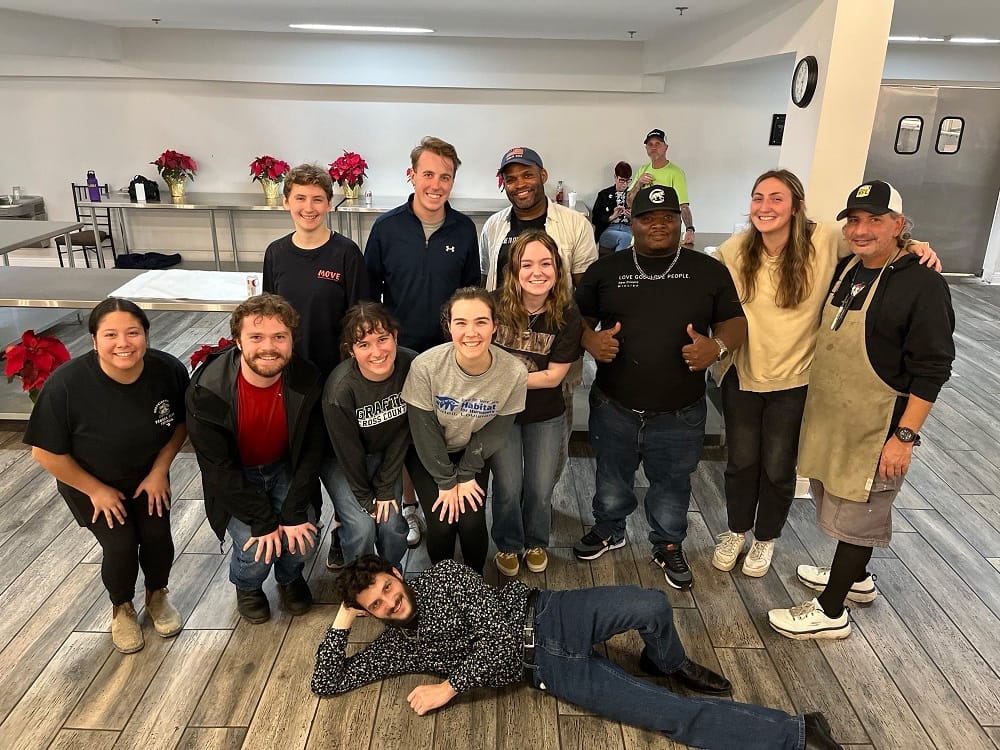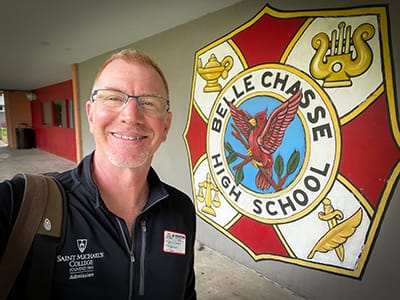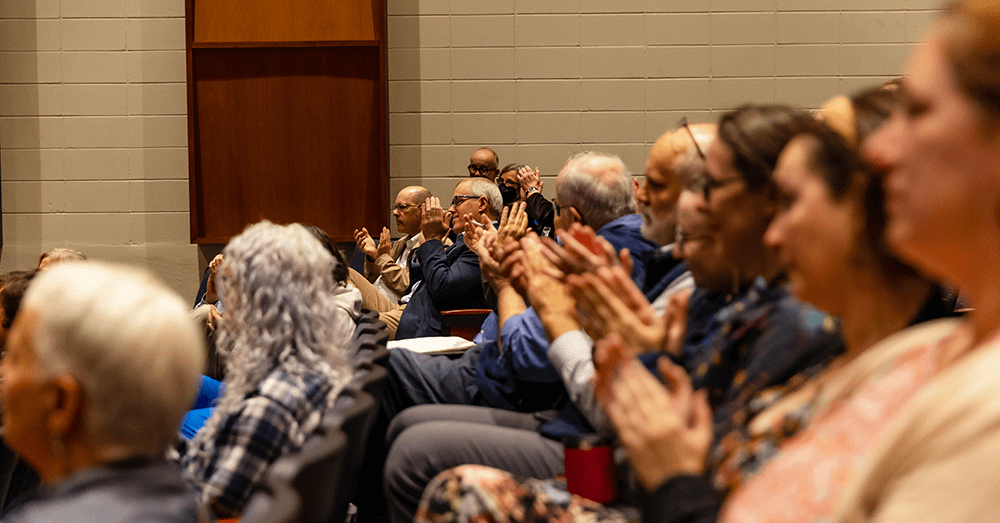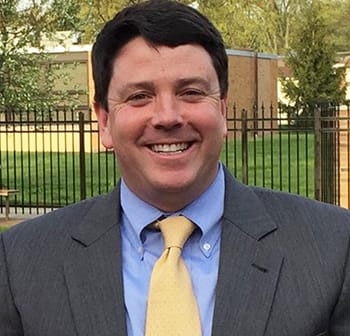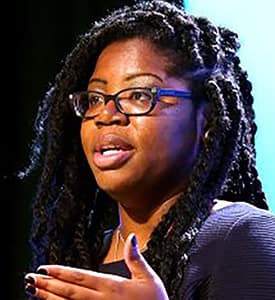Students from eight Saint Michael’s Accelerated Summer College first-session classes (May 22-June 30) concretely demonstrated for close to 100 people midday on Thursday just how much well-guided and eager college learners can accomplish in a few weeks.
Each group that spoke illustrated skills essential in the workplace –collaboration and the ability to focus productively on a tight deadline — as disparate presenters explained their work in the fields of education, technology, marketing, entrepreneurship, photography, and music history & culture.
Students, instructors, Saint Michael’s administrators and a cross-section of the summertime campus community gathered for this second annual ASC Showcase in the Roy Room of the Dion Family Student Center. It began with multimedia group presentations, followed by a poster session to allow more informal questions and conversations.
“We want to be sure students understand that ASC classes are academically rigorous, even though they use an accelerated and blended approach (in-class and on-line), said ASC Director Kellie Campbell of the summer college that is now in its fourth year. “They’re doing a lot in six weeks.”
Campbell said she had extra help pulling the show together this year from this summer’s management classes, taught by Karen Popovich of the business faculty, who volunteered to have her students take on as a sort of real-life management lab the organization and practical production of this ASC Showcase itself.
The added poster session, in fact, was a creative innovation by that class, who felt it would provide more opportunities for a wider range of ASC students beyond just presentations to a seated audience, as was the case last year. They were the day’s first presenters, explaining how their collaboration with Campbell and her student intern, Alex Colletta of Worcester, MA, applied management theory and techniques using the “SMART” formula: “specific, measurable, achievable, results-oriented and (having) target dates.”
Students told how they assigned roles, achieved milestones and resolved conflicts with effective communication through arranging the Showcase and related activities, from food to invitations to communication with students, professors, ASC leaders, and other logistics. Several said the biggest lesson learned was how important time-management is to success. Celena O’Brien ’18 of Burlington was the project manager for the Showcase.
Next up was Professor Jerry Swope of the College’s Media Studies, Journalism and Digital Arts faculty, who took to the podium with students from his ASC Wilderness Photography class. They described the weeks they spent developing visual storytelling skills, focused on nature, outdoor recreation and tourism, partnering with the Vermont Department of Tourism and marketing to create content for the department’s “251 Campaign” that encourages visits to Vermont’s unique 251 towns.
For the Showcase, four student groups from this Swope class took to a computer at the podium that projected onto two Roy Room large screens both the short-format and longer-version promo videos for the towns they chose to cover: Middlebury, North Hero, Shelburne and Quechee. State tourism officials attended the presentations.
Each group’s spots had beautiful and striking images of their respective towns, high production values, creativity and nice soundtracks, and the audience responded with enthusiastic applause. Students told how fun it was getting out of the classroom to capture images of biking, kayaking, balloon festivals, cliff-jumping, a toy store, a wine festival and brewing facility, cafes and quaint downtowns, boating and more.
The next presenters were from an ASC class with instructor Gordon Glover called Animation and Motion Graphics. They shared reels of work-in-progress from their final exercises that culminated their weeks of working through the animation and motion graphics toolbox such as Adobe, explained instructor Glover, who is an experienced animator. One student’s reel showed his newfound skill with layering effects, involving eyes and Vermont buildings in mind-blowing sequences. Another had an extreme sports theme, using effects to segue from GoPro images of helicopter skiing to kite-surfing or rock climbing (the audience saw a sample of the concept and beginning); and the last student chose a 1930s black-and-white cartoon sensibility to make a short creative music video.
The group that followed – Professor Robert Letovsky’s marketing class — described their computer simulation of marketing over-the-counter cold medicines. They learned all about market forces and challenges of introducing new products — often the hard way when a decision or initiative didn’t work out. “Choosing the wrong solution can have negative results,” one student offered. Another pair said they were “over-aggressive out of the gate,” but they described how they gamely forged ahead to get some more positive results near the end of the simulation.
After that final presentation, the audience moved on to view poster presentations on tables around the Roy Room or just outside, with students explaining the significance of their work.
Megan Perry and Dan Berry were two students from the History of Rock music course with Professor William Ellis. Beyond the class’s regular exploration of rock music’s roots and impact, they chose to study more in-depth about “Punk Fashion” – the style and clothing associated with this groundbreaking music style that started in the 1970s in New York and London (Ramones, Sex Pistols). Their poster had examples of such clothing and accessories and key figures in the punk movement, and they had created a playlist of songs to set the mood for viewers. Berry is an economics and political science double-major from Dover, MA, while Perry is a senior from Duxbury, VT and an international relations major.
A group from Professor Rob Williams’ entrepreneur class presented their business, marketing and multimedia plans for a real-world product – “Fro Pro” protein bars, which already has a market foothold in Florida where it is based, and whose founders had asked the class to investigate ways to expand into Vermont. Students said their ideas included athlete sponsorships, or promotions at outdoor sports venues in Vermont such as ski areas.
Another Popovich class, Management Information Systems, worked with Campbell and Colletta to develop an interactive dashboard for the ASC program using Microsoft Excel. The students showed how they took data from a relatively dense and confusing Excel data chart and turned it into colorful and clear graphic presentations tracking key performance indicators, metrics and other data from Summer College enterprise, through the use of graphs and charts, which will be useful to ASC planners for next year.
Students from Doyle’s Culture of Making class in the hallway outside the Roy Room told how their work helped build awareness of the “Next Generation Science Standards,” particularly pertaining to middle-level engineering standards for public schools across the nation. Doyle said that, more significantly, “we had the opportunity to learn in an environment where we could fail fast and fail frequent, replacing motivation by ‘judgement’ (grades) with motivation by problem solving.” Students described skills they learned with the MakerSpace’s 3D printer, vinyl printer and laser-cutter to demonstrate independent, constructive and collaborative learning.
Eric Roy, the MakerSpace technical specialist, says this was the second iteration of a course he’d worked on last year with Doyle. They found more success this year by incorporating mandatory work sessions as a primary focus, as opposed to a more academic and classroom focus last year, he said. This year’s version was all about “having students leverage their individual strengths and work together toward the engineering or time-management challenges,” he said, noting how some students had more of an education background, others a more technical background, yet each was able to put forward his or her strength to complement the others.
“There was so much experimentation that was student-led, and their passions and incentives really modified things,” Roy said, explaining how flexibility with assignments within concrete teaching objectives proved to be a winning formula. One student engaging warmly with visitors was a University of Vermont childhood education major – Miriasza Borsykowsky — who said the “pin boxes” that students used (resembling mini pinball machines) are created by a Burlington-based company, and the founder talked to the students about how to use the basic templates as a starting point for their more elaborate and creative builds. (ASC classes are open to non-Saint-Michael’s students, who are actively recruited through marketing, though Saint Michael’s students remain the vast majority).
Said Roy of the students, “they came up with better stuff than we ever could – one of the wonderful parts of how MakerSpace has been working is that by putting students first and really looking where their interests and passions lie, they’ve been able to drive success that I never would have been able to pre-visualize. My job pretty much has been to keep up!”
